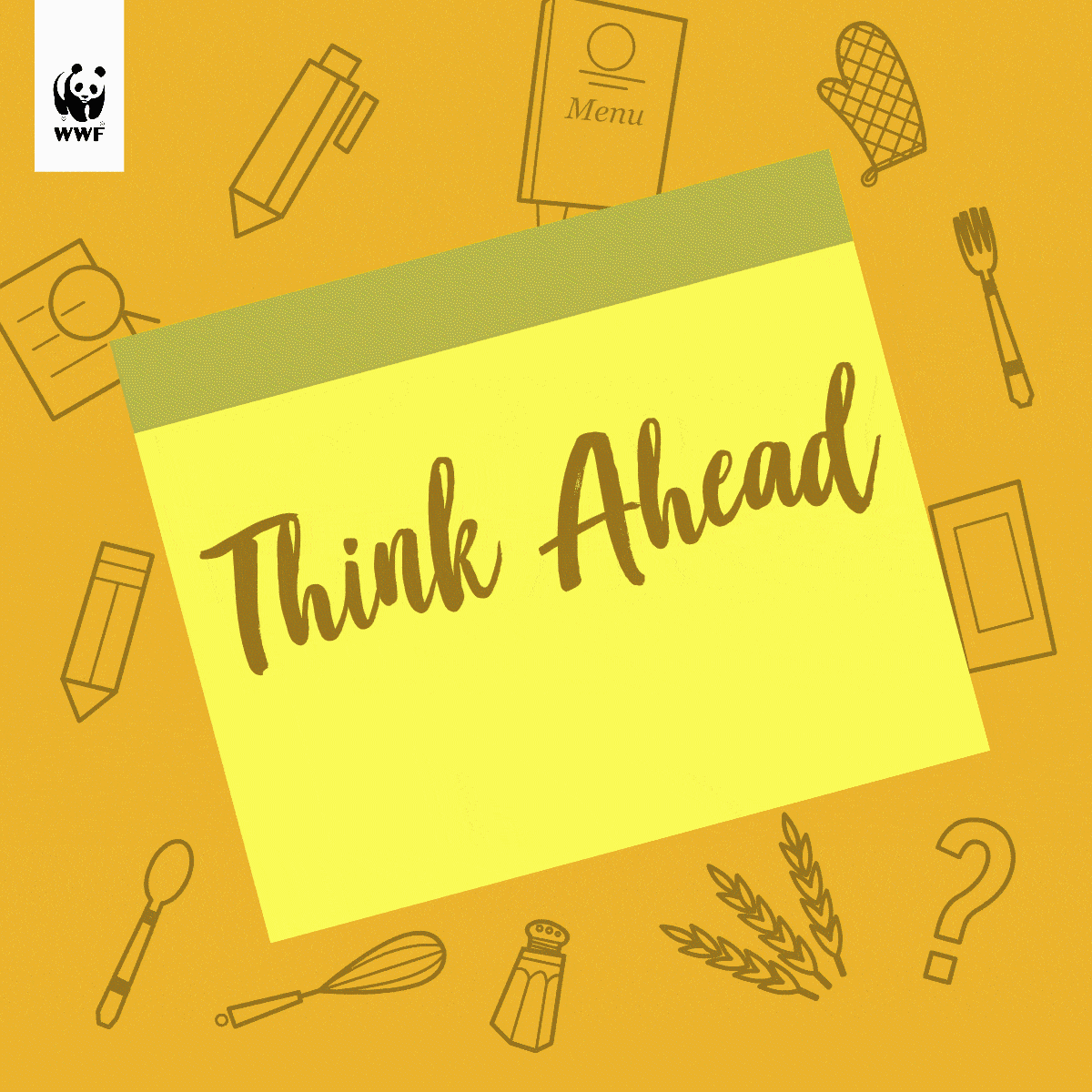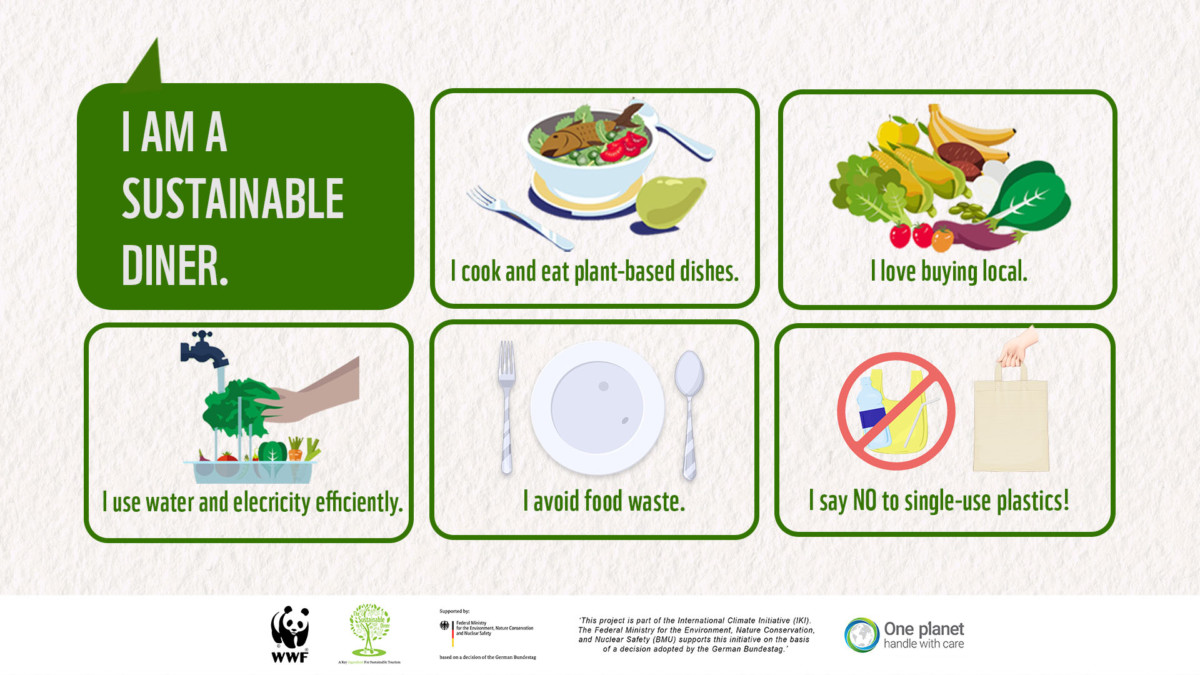Be a Sustainable Diner at Home
April 2020

Make the most out of our food resources and savor their many benefits — saving time and money, reducing market trips and carbon footprint, conserving energy and resources, improving health and wellness, and supporting the community by promoting a healthy well-being and environment for all.
1. Think Ahead

Create a shopping list
Are you going for a grocery or market run? Make the best out of your trip by having a list of what to buy. Know how to select food that is nutritious, preferably in season and locally grown, and will last long (non-perishable) even without a fridge.
Examples: local vegetables (squash, eggplant, green papaya, upo, etc.), root crops (cassava, sweet potato, etc), legumes (such as bataw, peanuts, monggo beans, string beans) and other locally grown nutritious veggies, those with a short shelf life and would need to be consumed within a few days: alugbati, sigarilyas, malunggay, kangkong, camote tops, etc.
Check the storage
Check your food inventory first! Keep food safe by doing the “First In, First Out” (FIFO) method. The food that has been stored the longest (first in) should be the next food to be consumed (first out). Also, consume first food items with shorter shelf life and check expiration dates. Cook and eat what you already have at home before buying more.
Plan your meals
Create a cycle menu or plan what you’re going to eat for each week to determine the quantity and types of food to purchase. This will lessen your trips, and will save time and money. For the menus, give preference to simple dishes that can be made using a variety of locally sourced nutritious food such as corn, peanuts, or banana and other fruits and seafood available. Food items that are in season are plenty and affordable, so it's a good idea to include these in your market list. Also, try exploring simple home food preservation techniques such as pickling (ie. atchara, pickled kamias), salting (ie. tinapa, daing) or freezing, to extend shelf life.
2. Grow Your Food

Start your home garden
Be food secure and healthy by planting and harvesting your home-grown nutritious foods! Plant your own garden in land spaces around your home, or in pots or recycled containers. Learn to grow varieties of nutritious food crops, fruits, and vegetables that you love to eat. Home gardening is fun, is a good exercise, and it also helps reduce stress.
Plant indigenous vegetables
Grow diverse nutritious indigenous vegetables, and easy to grow and low maintenance food crops. There are short-term crops that can be harvested after 30 days, including kangkong, alugbati, kulitis, pechay, leeks, sweet potato tops, talinum, and lettuce. There are also drought-tolerant vegetables that can grow during hot summer seasons, like eggplant, mung bean, peanut, sitaw paayap, bataw, okra, patani and kadyos, and other root crops like cassava and sweet potato.
Be creative with your next meal
Cook a variety of dishes using available leftovers and food stocks or produce from your home garden. Prepare simple and nutritious recipes just enough in quantity, which the household members will love to eat. Avoid food spoilage, and ensure safe and proper preparation and handling of food at all times.
3. Compost

Segregate organic wastes
Save and reuse your kitchen food waste by composting fruit peels, vegetable scraps, coffee grounds, eggshells, leftover food, and soon you will have your own ready organic fertilizer to enrich your soil garden.
Use as fertilizer
Combine your home gardening with backyard composting, and have your own organic fertilizer. Compost helps improve overall soil health which is great in enriching our home garden. By turning food waste into compost, we are giving important nutrients back to the soil.
4. Cook meals safely

Help when you can
Support your household and community to be food secure and safe by promoting nutritious homegrown food and home-prepared nutritious meals. Be proactive and lend a helping hand whenever you can.
Share with others
Advocate for and spread the word about being a sustainable diner to your families, neighbors, and communities by sharing your good experiences in home gardening, composting, food marketing, preparation, and cooking. Post, comment, and share some tips in cooking and reducing food waste, as well as your favorite nutritious recipes with family and friends.

References:
- Food and Agriculture Organization of the United Nations (FAO), 2019. The Future of Food Safety, There is no food security without food safety. Retrieved from: http://www.fao.org/3/ca4289en/CA4289EN.pdf
- International Institute of Rural Reconstruction (IIRR), 2018. Bio-intensive Gardening (BIG) Handouts: Crop Planting Guide. Retrieved from: https://schoolnutritionphils.files.wordpress.com/2018/08/3-crop-planting-guide.pdf
All sources were accessed on April 14, 2020.
The Sustainable Diner and SoilMate Project Team:
Melody Melo-Rijk, Jonna Ellaine Jordan, Lorayne Therese Roque, Alexa Jeanne Lasch, Iris Joy Abrigo, Liezl Stuart del Rosario, Kristan Gabriel Villalon, Jenette Callada, Monique Mahusay
For more information, please contact:
Melody Melo-Rijk
Sustainable Consumption and Production (SCP) Project Manager
mmelorijk@wwf.org.ph
Jonna Ellaine Jordan
Integrated Marketing Communication Specialist
jjordan@wwf.org.ph
Lorayne Therese Roque
Sustainable Consumer Specialist
lroque@wwf.org.ph
